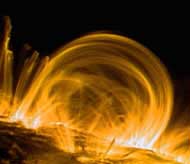Space weather forecast step closer

Loops of hot electrified gas above an active sunspot <br>© NASA/Standford University
American Geophysical Society Meeting, San Francisco, December 2001
The Sun’s violent outbursts have deep and twisted origins.
The Sun’s violent eruptions of material and magnetic energy have deep and twisted origins, researchers told this week’s American Geophysical Union Meeting in San Francisco, California.
These coronal mass ejections (CMEs) cause the aurora, seen at the Earth’s poles, and can knock out spacecraft. An understanding of what drives CMEs may one day make them possible to predict.
Radar aboard the NASA/European Space Agency spacecraft SOHO allowed a team from Stanford University in California to look beneath sunspots – dark patches on the Sun associated with CMEs.
Sunspots have been studied for centuries, but were thought to be exclusively a surface phenomenon. The researchers find that they in fact extend at least 100,000 kilometres below the Sun’s surface. “This is the first evidence that their roots go deep into the interior,” says team member Alexander Kosovichev.
An examination of another sunspot by Junwei Zhao, also of Stanford, reveals magnetic field lines beneath the surface twisting around one another into bunches as the sunspot forms. “A huge amount of energy builds up in these bunches,” says Zhao. When released, this would trigger a CME hurling solar material into space.
Sunspots had been observed rotating before, says Richard Nightingale, a solar physicist at Lockheed Martin in Palo Alto, California. “The coupling of above and below – that’s all new,” he says.
Beneath the surface
“The interior of the Sun was simple before there were data,” says Philip Scherer, who led the research. Models of the Sun’s interior assumed that buoyant hot material rose to the surface, where it was whipped up by the magnetic field lines that criss-cross the star’s exterior, forming sunspots and leading to CMEs.
Now it appears that material rising from deep within the Sun can twist magnetic field lines, giving them more energy. “Convection is being converted into magnetic fields,” says Scherer.
This may produce the giant loops of overstretched magnetic fields that arch out of sunspots. The snapping of these loops releases energy, causing CMEs. Why the processes occur at specific locations is still a mystery.
The structure below the surface is currently too complicated to predict accurately, according to George Fisher, who models the Sun’s behaviour at the University of California at Berkeley. More data from sunspots may reveal patterns in the rising solar material and their interactions with magnetic field lines. “In about five years’ time we should be able to model some kind of real events,” he says.
Fisher aims to use data from SOHO and future missions to model the Sun’s magnetic field completely. Then he hopes to be able to spot CMEs stirring within the Sun and to forecast the resulting weather in space.
Media Contact
All latest news from the category: Physics and Astronomy
This area deals with the fundamental laws and building blocks of nature and how they interact, the properties and the behavior of matter, and research into space and time and their structures.
innovations-report provides in-depth reports and articles on subjects such as astrophysics, laser technologies, nuclear, quantum, particle and solid-state physics, nanotechnologies, planetary research and findings (Mars, Venus) and developments related to the Hubble Telescope.
Newest articles

Superradiant atoms could push the boundaries of how precisely time can be measured
Superradiant atoms can help us measure time more precisely than ever. In a new study, researchers from the University of Copenhagen present a new method for measuring the time interval,…

Ion thermoelectric conversion devices for near room temperature
The electrode sheet of the thermoelectric device consists of ionic hydrogel, which is sandwiched between the electrodes to form, and the Prussian blue on the electrode undergoes a redox reaction…

Zap Energy achieves 37-million-degree temperatures in a compact device
New publication reports record electron temperatures for a small-scale, sheared-flow-stabilized Z-pinch fusion device. In the nine decades since humans first produced fusion reactions, only a few fusion technologies have demonstrated…





















